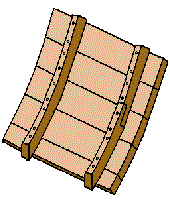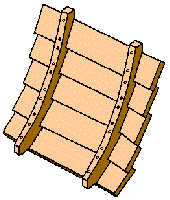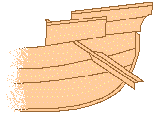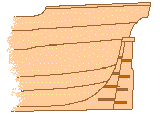A hollow vessel built for travel over water and provided with a means of propulsion and navigatation, ships have been used by mankind since the Stone Age. The earliest form of transport on water must have been a fallen or felled log which the earliest mariners could sit astride. Hollowing out the log to make a 'dug-out' was a natural step along the path to the evolution of the boat or ship and such vessels were widespread amongst primitive cultures into the twentieth century. To aid the mechanical ectraction of the wood, carefully tended fires were used to burn it away before the craft was tooled to a finish.
An early example of such a 'dug-out' was discovered during the dredging of Poole Harbour to the north of Brownsea Island in Dorset. Dating from c. 2,950 BC, the 10 metre (30 ft) long boat is displayed in Poole Museum.
In the Mediterannean, the open dug-out developed into the open 'galley'
made of boards fastened to a skeleton of keel and ribs, with or without a single sail to make use of whatever wind
was available, but primarily reliant on a bank of oars on each side. While such a deckless vessel might suffice
for trade with a rudimentary superstructure such as a hut or tent to protect precious cargo or important passengers,
military galleys required a sturdy platform from which soldiers could fight as well as banks of rowers. This led
the the development of a deck, with soldiers above and oarsmen below and achieved its height in the Greek
'triremes' with three banks of oars on each side.
In Europe the Vikings emerged from their homelands in the eighth and ninth centuries to raid Northern Europe
in their fast narrow longboats. Eventually, they realised they could grasp the lands as well as movable plunder
and began to settle as conquerors. They traded overland deep into the east, founding Kiev in Russia, into the Mediterannean
and overland as far as Constantinople. The traders required vessels which could carry heavy loads and reconstructions of
five of their ships found near Roskilde have been reconstructed at the museum there showing the trading vessels were as
much as thirty-six metres long and could carry loads of up to twenty four tons.
The influx of northern Europeans into the Mediterannean caused by the Crusades (1099-1291) brought together the ship-building traditions of the two regions; in the Mediterannean, hulls were carvel-built and the square sail had been abandoned for about a millenium in favour of the traingular lateen sail; in Northern Europe, the square sail still prevailed and hulls were clinker-built (with their boards overlapping) - a method which was found to be unsuitable for the building of the larger ships of the fifteenth century because it became more difficult to keep them water-tight.
 | |  |
| Carvel-Built Hull | | Clinker-Built Hull |
|
The English 'Grace Dieu' built in 1418 was the largest clinker built ship constructed and a failure leading to the adoption of carvel hulls for large vessels.
|
In the Mediterannean and Northern Europe until the early 13th century, ships were steered by means of oar-like rudders hung from the sides of the ship. Frequently, the vessel would be equipped with only one rudder which meant that the ship would have to be docked with the rudder away from the quay giving rise to the terms 'port' (left) and 'starboard' (right) for the sides of the ship. In the early 13th century, ships in Northern Europe were equipped with a central rudder hinged to the sternpost and controlled with a lever attached to it and this innovation was introduced into the Mediterannean by the Crusaders.
 | |  |
| 12th Century | | Early 13th Century |
|
As ships gradually grew larger in size, the helmsman would steer according to commands shouted to him below decks but, unlike a motor vessel, steering a sailing ship always involves co-ordination between the crew handling the sails and the helsman.
|
Until the fifteenth century, the square-rigged ships usually only carried one mast with a single sail.
"Castles" were built above the stem
(forecastle) and stern (aftcastle) of the
ships for use in naval battles, much as their land-based namesakes were - until the sixteenth century
sea battles ceased to be faught just like land battles, the aim being to board the enemy and overpower them (a position reflected in the title of the admirals of the time, known as "Generals-at-Sea"). Sometimes, as was the case with the
Cinque Ports, the castles were temporary structures which were kept ready and built up on fishing and other vessels when
required. The development of the castles provided more space aboard the ships and allowed the development of
stern quarters for the ship's officers.
|
| | | Links to Other Pages on this Site
|
| |
| | |
|
| | | Links to Other Sites
|
| |
| | |
Recommend a Book for this Page
Hits on this page since December 6th| Jan | | |  | | Feb | | |  | | Mar | | |  | | Apr | | |  | | May | | |  | | Jun | | |  | | Jul | | |  | | Aug | | |  | | Sep | | |  | | Oct | | |  | | Nov | | | | | Dec | | |  |
current year:  | | previous year:  |
No messages posted on this page Only Members of the Site can post messages in this section. Signing in is easy from our Home Page. DISCLAIMER: Whilst we endeavour to ensure the content of this site is correct, we cannot undertake that information you find here, is, or will remain accurate and complete. We do not warrant that any information contained on this site is fit for any purpose. If you wish to place reliance on any such information you must check its accuracy by some other means before doing so. MEMBERS get aditional features on our pages and will soon be able to interact with the site and add their views and informastion. Sign up, from the Home-Page, is simple and involves typing in your email address and a password of your choice. If you are in any way connected with any location or interested in the subject mentioned on this page and have an hour or two a month to spare, we would welcome you as a local moderator - please email the webmaster by CLICKING HERE. Privacy Policy
|
|










